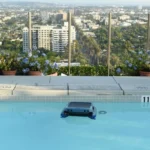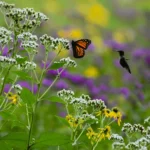A butterfly or pollinator garden is a carefully designed green space that attracts and supports pollinators such as butterflies, bees, hummingbirds, and other beneficial insects.
These gardens are essential for maintaining biodiversity, enhancing plant pollination, and promoting environmental health.
Creating a pollinator garden also contributes to climate resilience by supporting native flora and fauna.
This guide provides a comprehensive step-by-step approach to designing, planting, and maintaining a thriving pollinator-friendly garden in your backyard.
Benefits of a Pollinator Garden
Pollinator gardens provide numerous ecological, aesthetic, and practical benefits. They not only support local wildlife but also improve the overall health of the environment.
| Benefit | Description |
|---|---|
| Increased Pollination | Supports the reproduction of flowers, fruits, and vegetables, leading to higher crop yields. |
| Biodiversity Enhancement | Encourages a variety of pollinators, strengthening ecosystems and preventing species decline. |
| Environmental Sustainability | Reduces the need for chemical fertilizers and pesticides by fostering natural ecological balance. |
| Aesthetic Appeal | Provides a vibrant, colorful landscape filled with flowers, butterflies, bees, and birds. |
| Educational Opportunities | Great for teaching kids and adults about ecology, conservation, and environmental responsibility. |
| Climate Change Mitigation | Helps sequester carbon, improve soil health, and enhance air quality. |
Choosing the Right Location
The success of a butterfly or pollinator garden depends on selecting the right location. Consider the following factors:
- Sunlight: Most pollinator plants thrive in full sun (at least 6 hours per day), although some shade-loving varieties exist.
- Wind Protection: Strong winds can deter pollinators, so choose a sheltered area with natural windbreaks like hedges or fences.
- Water Availability: Ensure a nearby water source for both pollinators and plant hydration.
- Soil Quality: Well-draining, nutrient-rich soil supports plant growth; consider testing and amending soil with organic matter as needed.
- Accessibility: Ensure easy access for maintenance and observation, as well as paths for enjoying the garden up close.
Selecting the Best Plants
Pollinators prefer native plants that provide nectar, pollen, and shelter. A well-designed garden includes a variety of plants that bloom throughout the seasons to sustain pollinators year-round.
Recommended Plants for a Butterfly or Pollinator Garden
| Pollinator | Favorite Plants | Additional Notes |
|---|---|---|
| Butterflies | Milkweed, Butterfly Bush, Purple Coneflower, Lantana | Provide host plants for caterpillars, such as parsley and dill. |
| Bees | Lavender, Sunflowers, Wild Bergamot, Clover | Include tubular and open flowers to accommodate different bee species. |
| Hummingbirds | Trumpet Vine, Salvia, Cardinal Flower, Bee Balm | Choose red, orange, and tubular flowers to attract hummingbirds. |
| Moths | Night-blooming Jasmine, Evening Primrose, Phlox | Night-blooming flowers provide nectar when moths are active. |
| Beetles | Goldenrod, Yarrow, Daisies | Beetles pollinate plants with strong scents and large, open flowers. |
Plant Selection Tips
- Go Native: Native plants are adapted to local climates and require less maintenance.
- Ensure Diversity: Select plants with different blooming seasons to provide nectar and pollen year-round.
- Cluster Planting: Group flowers together to make nectar collection easier for pollinators.
- Layer Heights: Incorporate trees, shrubs, and ground cover to create varied habitats.
- Avoid Hybrid Plants: Many hybrids lack nectar and pollen, reducing their attractiveness to pollinators.
ALSO READ: How to Incorporate Smart Home Features into Exterior Design?
Creating a Pollinator-Friendly Environment
Water Sources
Pollinators need fresh water for hydration. Consider the following:
- Shallow Dishes: Fill with pebbles and water to provide a safe drinking spot for butterflies and bees.
- Birdbaths: Ensure they are shallow, have perches, and are cleaned regularly to prevent mosquito breeding.
- Mud Puddles: Some butterflies and bees obtain essential minerals from moist soil patches.
- Dripping Water Features: Create a gentle water source, like a slow drip from a container, for consistent hydration.
Shelter and Nesting Areas
Pollinators need safe places to rest and reproduce. Options include:
- Butterfly Houses: Provide protection from predators and harsh weather.
- Bee Hotels: Create nesting sites for solitary bees using drilled wood or bamboo tubes.
- Dense Shrubs and Trees: Offer hiding spots, roosting areas, and protection from wind and rain.
- Leaf Litter and Logs: Allow some organic debris to remain, supporting overwintering insects and larvae.
Avoiding Harmful Chemicals
Chemical pesticides and herbicides can harm pollinators. Follow these eco-friendly gardening practices:
- Use Organic Pest Control: Introduce beneficial insects like ladybugs and praying mantises to keep pests in check.
- Companion Planting: Grow pest-repelling plants such as marigolds, basil, and garlic alongside vulnerable species.
- Hand-Picking Pests: Remove harmful insects manually to avoid the need for chemical treatments.
- Neem Oil and Insecticidal Soaps: Use natural alternatives to pesticides that do not harm beneficial insects.
Seasonal Garden Maintenance
Each season requires different care techniques to maintain a thriving pollinator garden.
| Season | Maintenance Tasks |
|---|---|
| Spring | Plant new flowers, remove weeds, and set up water sources. Add mulch to retain moisture and suppress weeds. |
| Summer | Regularly water, deadhead flowers to encourage new blooms, and monitor pollinators. Add supplemental nectar plants if necessary. |
| Fall | Leave dried plant stems and seed heads for overwintering insects. Collect seeds for next year’s planting. |
| Winter | Mulch soil for insulation, avoid disturbing dormant insects, and plan for early spring planting. Keep leaf litter intact for shelter. |
Enhancing the Garden with Additional Features
- Pathways and Seating: Enjoy the beauty of the pollinators up close with benches and stepping stones.
- Signage and Labels: Educate visitors about different plant species and the pollinators they attract.
- Climbing Plants and Trellises: Add dimension and increase nectar sources for climbing species.
- Native Grasses and Wildflowers: Incorporate meadow-like areas for additional habitat diversity.
- Rock Piles and Logs: Provide hiding spots for beetles, spiders, and ground-dwelling pollinators.
ALSO READ: How to Stage Your Home for Maximum Appeal?
Conclusion
A butterfly or pollinator garden is a rewarding addition to any outdoor space. By selecting the right plants, providing essential resources, and maintaining a safe environment, you can create a thriving habitat that supports pollinators and enhances biodiversity.
Start planning your pollinator-friendly garden today and contribute to the conservation of these vital creatures!
Your efforts will not only help pollinators but also create a serene and visually stunning outdoor retreat that benefits both nature and your well-being.







